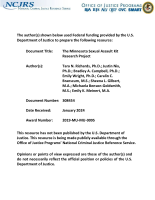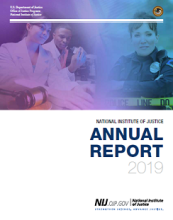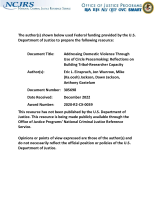Capacity enhancement
Taku Eyachantognaka Owihankeya Wanica, Tribal-Researcher Partnership Lessons Learned
Building the Capacity of Community-Facing Agencies to Implement Evidence-Based Practices
Enhancing Risk-Need-Responsivity Implementation: An Evidence-based System for Case Management Support
American Association for the Advancement of Science (AAAS) Science & Technology Policy Fellowships 2024-25
Assessing the Impact of an Innovative Response to Intimate Partner Violence Related Strangulation, Final Report & Outcome Evaluation
Building "A Beautiful Safe Place for Youth" Through Problem-oriented Community Organizing: A Quasi-experimental Evaluation
Webinar Transcript: Fiscal Year 2024 Evaluating Strategies to Advance the Implementation of Evidence-Based Policies and Practices Solicitation
This webinar provided an overview of the NIJ FY 2024 Evaluating Strategies to Advance the Implementation of Evidence-Based Policies and Practices solicitation, in which...
Sexual Assault Response Team Goals and Motivations for Development
Webinar Transcript: NIJ FY 24 Research and Evaluation on the Impact of Technologies for Forensic Science Applications
This webinar provided information about the "FY 24 Research and Evaluation on the Impact of Technologies for Forensic Science Applications" solicitation. NIJ seeks applications for funding for proposals to study how adopted technologies with a forensic science application impact criminal justice systems, how the implementation of forensic laboratory...
The Minnesota Sexual Assault Kit Research Project
Grant Opportunities for Medical Examiner Facilities
,
Associations between a technical assistance model to build school organizational capacity and improvements in student perceptions of school climate
Forgotten Evidence: A Mixed Methods Study of Why Sexual Assault Kits (SAKs) Are Not Submitted for DNA Forensic Testing
NIJ Community Violence Intervention Research and Evaluation Training and Technical Assistance (TTA) Center
Implementation of a Capacity-Building Framework to Improve School Climate in an Urban School System
Pathways to Resilience: Assessing the Impact of Juvenile Justice Reforms in Oklahoma
Driving Down Gun Violence, Part 1
Three LEADS Scholars serving in different law enforcement agencies and positions discuss their experiences with identifying and implementing evidence-based interventions to reduce gun violence. NIJ Senior Advisor Dr. Tamara Herold hosts this conversation with guests Police Chief Cecilia Ashe (Milford Delaware Police Department), Chief of Staff Lieutenant Matthew Barter (Manchester, NH Police Department), and Analytical Services Manager Mr. Jason Schiess (Durham, NC Police Department).
Enhancing the Effectiveness of Juvenile Drug Courts by Integrating Evidence-Based Practices
NIJ FY23 Tribal-Researcher Capacity-Building Grants
UAA Research on Violence Against Women
Gender-Based Violence and the Latinx Community
See the YouTube Terms of Service and Google Privacy Policy








